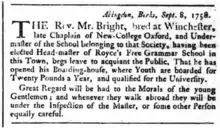Henry Bright (schoolmaster, born 1724)
Henry Bright (1724 – 31 January 1803) was an English clergyman, scholar and schoolmaster, who served as headmaster of Abingdon School (1758–1774) and New College School (1774–1794).
Henry Bright | |
|---|---|
 Reverend Henry Bright advertises the opening of his boarding house on 8 September 1758. | |
| Born | 1724 |
| Died | 31 January 1803 (aged 78) |
| Education | Winchester College |
| Alma mater | Trinity College, Oxford New College, Oxford |
| Occupation | Clergyman, schoolmaster |
| Employer | Abingdon School (1758–1774) New College School (1774–1794) |
| Ecclesiastical career | |
| Religion | Church of England |
| Ordained | June 1747 (deacon) March 1748 (priest) |
Biography
Bright was the son of Rowland Bright of Argeville, France[1] (where the statesman Lord Bolingbroke was then living in retirement).
He was educated at Winchester College.[2] He matriculated at Trinity College, Oxford in 1743, aged 19, and at New College, Oxford graduated BA (1747) and MA (1761).[1] Ordained deacon in June 1747 and priest in March 1748,[3] he became a Fellow and chaplain at New College,[2] and under-master at New College School.[4]
He was headmaster of Roysse's Free School in Abingdon (now Abingdon School) from 27 July 1758 to 1774. In 1758 Bright advertised the opening of his student boarding house,[4] one of several adverts that he posted in Jackson's Oxford Journal.[2] In 1763, to celebrate the school's bi-centenary, Bright commissioned a wooden panel painted with a coat of arms (the arms of founder John Roysse impaled on an unknown quartered shield) and the motto Misericordias Domini in Aeternum Cantabo (I will sing of the Lord's mercies forever), the opening line of Psalm 89. Though the coat of arms is no longer in use, the school motto endures.[5]
Bright left Abingdon when appointed headmaster of New College School, Oxford in 1774, continuing until 1794. His tenure coincided with that of Philip Hayes as organist. According to Matthew Jenkinson, this was a high-point in the school's history, the school having good-quality academic and music teachers, and the choir enjoying a high reputation.[6]
He was the author of Praxis, a Latin and English textbook for schools published in 1783.[7]
He held the following church livings:
- Preacher at St Helen's Church, Abingdon and Marcham, Berkshire (1758)[8]
- Curate of Waldron, Sussex (1758)
- Vicar of Denchworth, Berkshire (1775)[9]
- Vicar of Chittlehampton, Devon (1794)[10]
- Rector of Bicton, Devon (1797–1803)[11]
Having been in ill health for several years previously, he died on 31 January 1803 at his home in Oxford.[12]
References
- Foster, Joseph. Alumni Oxonienses: Bright, Henry. p. 160 – via Wikisource. [scan
 ]
] - Preston, Arthur Edwin (1929). St.Nicholas Abingdon and Other Papers, pre isbn. Oxford University Press. pp. 357–359.
- Persons: Bright, Henry (–) in "CCEd, the Clergy of the Church of England database" (Accessed online, 26 August 2019)
- "The Rev. Mr. Bright". Jackson's Oxford Journal. 8 September 1758.
 Media related to the advert at Wikimedia Commons
Media related to the advert at Wikimedia Commons - "Object 15: Bright's Coat of Arms". Abingdon School.
- Jenkinson, Matthew (2013). New College School, Oxford: A History. Bloomsbury. ISBN 978-0747813972. Retrieved 26 August 2019.
- Bright, Henry (1783). The Praxis: Or, a Course of English and Latin Exercises. Retrieved 25 August 2019.
- "London". The General Evening Post. 12 August 1758. Retrieved 26 August 2019.
- Nevill, E. R., ed. (1914). The Registers of Denchworth, Co. Berks., 1540–1812. London. p. 61. Retrieved 26 August 2019.
- "For November 1794: Promotions". The Freemason's Magazine, or General and Complete Library. London. 1795. p. 381. Retrieved 26 August 2019.
- Oliver, George (1840). Ecclesiastical Antiquities in Devon. 1. Exeter: W. C. Featherstone. p. 102. Retrieved 26 August 2019.
- "Deaths". The Gentleman's Magazine and Historical Chronicle. Vol. 73 no. 1. 1803. p. 196, 475–476.